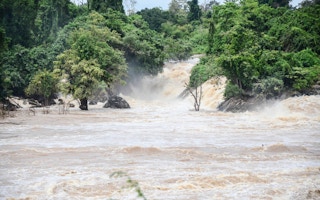Climate change-induced natural hazards in the Upper Indus Basin (UIB) of Hindu Kush Himalaya (HKH) region of Pakistan have started severely affecting lives and livelihood of the local inhabitants. Social and physical infrastructure is critically endangered, and there seems little hope that things will change for the better as risks to irrigation and agriculture increase. These natural disasters include flash floods, avalanches, Glacier Lake Outburst Floods (GLOFs), and landslides.
Before the recent April flash floods and landslides, nine people were killed in the Chitral district when a powerful avalanche hit, burying a number of people alive on March 19. A number of the victims were schoolchildren coming back after taking their exams.
Surveying disaster risks in northern Pakistan
Climate change induced hazards are increasing in these areas and a recently survey report shows that 125 out of the 620 villages, or 20 per cent, in the four districts of the upper Indus Basin of Pakistan are highly vulnerable to the multiple natural hazards. The survey was conducted by Focus Humanitarian Assistance (FCA), a subsidiary of the Aga Khan Development Network, in four vulnerable districts of northern Pakistan including Chitral, Ghizer, Hunza and Nager. The survey further shows that around 48 per cent of the houses (over 36,738 units) in four districts of Gilgit-Baltistan and Chitral fall under the category of “multiple hazard zones”.
Based on the survey, a paper was presented by the Chief Executive Officer of FCA, Nusrat Nasab at an International conference on climate change and environmental change Impacts on the Indus basin. The conference was held in Kathmandu, and jointly organized jointly by the International Centre for Integrated Mountain Development (ICIMOD) and the International Water Management Institute (IWMI) from 16 to 18 February 2016.
Nasab said that, while physical infrastructure damage is easily seen, social infrastructure is also vulnerable to natural disasters. 600 out of 1,312 schools (45 per cent) fall in the multiple hazard zones, and of these, 297 (23 per cent of the total) are at medium to high risk. Similarly, 1,165 out of 2,253 prayer halls, or 52 per cent, are located in multiple hazard zones, of which 592 (26 per cent of the total) are located in medium to high risk zones. Of the 271 health units in the area, 98 (36 per cent) are located in multiple hazard zones whereas 46 (17 per cent) are at medium to high risk. Over 356 bridges and 1,509 other facilities are also at risk.
She mentioned that natural disasters are increasing in number and frequency, and over 131 such events occurred between July 15 to August 3 in 2015, in the shape of GLOFs, debris flow and flash floods in Chitral and Gilgit-Baltistan, which resulted in the death of 37 people and damaged 260 villages, destroying agriculture lands, standing crops, irrigation channels, orchards, and injuring livestock.
Talking to thethirdpole.net, Nasab said that the growing disasters in these areas have far-reaching implication on the socio-economic situation of the local inhabitants, who mostly depend on agriculture and livestock. “The sources of livelihood of the villagers are largely affected due to change in weather condition, damaging of infrastructure and disturbances in the ecosystem”, she noted. These hazards have also led many to migrate to other cities. “Those people who don’t have the option to migrate remain at risk, and those risks are only growing,” she said.
She said that there is need for strengthening early warning systems and enhancing community preparedness. These, combined with better land use planning and strengthening government partnerships, were the only ways in which communities could be made secure.
The threat of landslides
Baber Khan, the head of WWF in Gilgit-Baltistan, said that hydro meteorological hazards are on rise in the mountainous areas of Upper Indus Basin due to climate change. Torrential rains and cloud bursts have increased in intensity, leading to frequent landslides. The disasters damage local communities, where the majority of the population is dependent on small landholdings. These continuously diminish in productivity and size.
Bajaur Khan, a farmer in one the Kalasha valley of Chitral said that it seems that they are in the epicentre of both the floods and earthquake, which has been playing havoc over the years. Recalling the 2010 floods, he said it was the dreadful moment, but 2015 floods were even worse and they lost everything. He said the last year’s flash floods inundated his orchards, standing crops and fertile arable lands. “Almost 80 per cent of my arable land was washed away. I managed to cultivate just two 40 kilogramme sacks of maize last year, instead of 30 sacks as I used to.”
Irrigation slows to a trickle, but GLOFs threaten
Hamid Ahmed Mir, an environmentalist in Chitral, added that diminishing fresh water resources are also adding to this mix. “Glacier water is the basic source of irrigation, which is decreasing at fast rate,” he said. He added that 80 per cent the irrigation channels damaged in last year’s floods have not been restored. “The recent rains have provided temporally relief, but most farmers do not have water for irrigation,” he said. “I think the miseries of these communities are growing with each year, not lessening.”
According to Manzoor Ahmed at the Pakistan Meteorological Department in Chitral, the rise of temperature in the region was also adding to the risks. Heatwaves, with temperatures reaching 42 C were new phenomena. “Unlike in the past, there were prolonged heavy rains, combined with high temperatures and humidity, which caused to outburst of glacier lakes”, he said.










